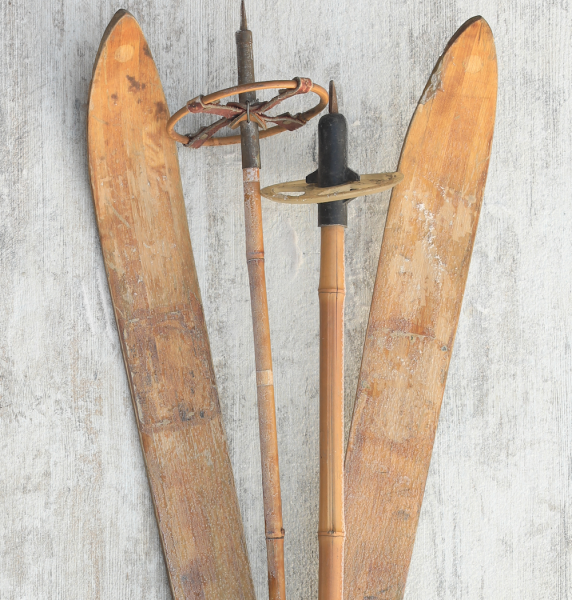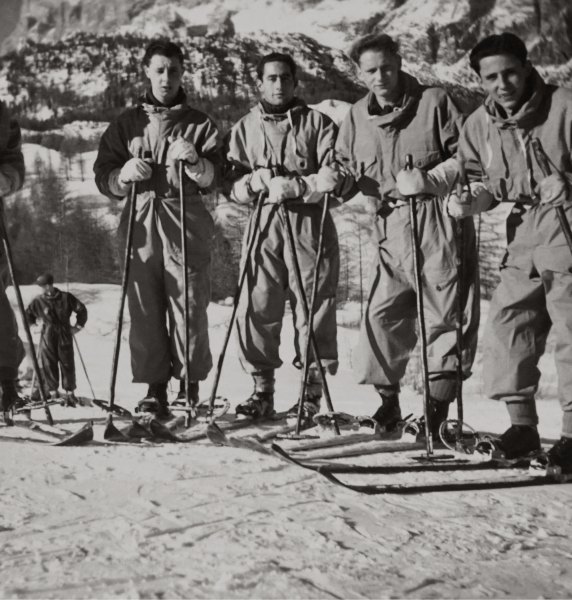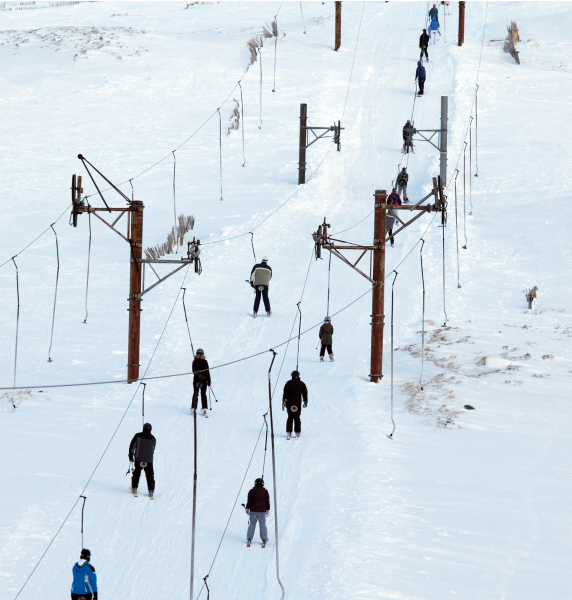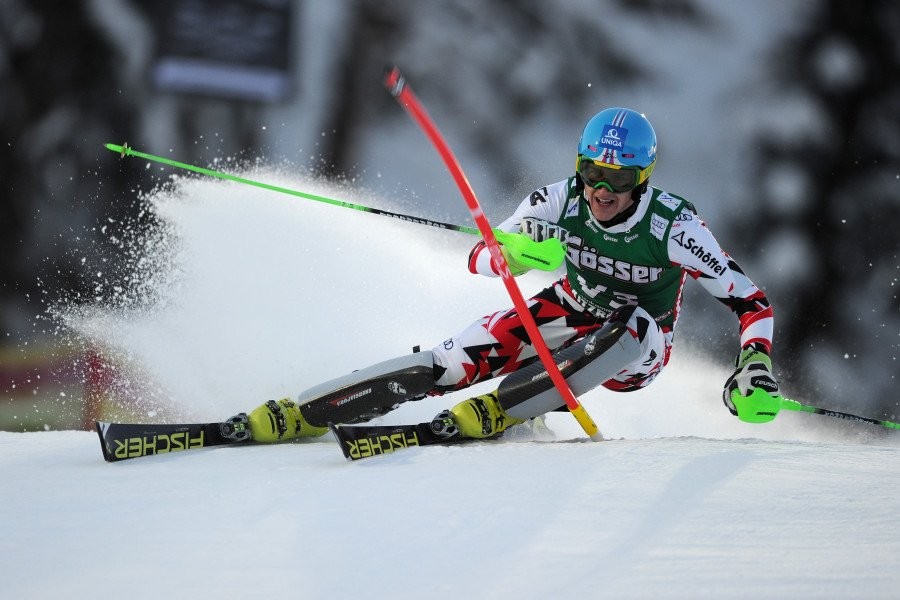Today, skiing is an essential part of the winter season. Millions hit the slopes every year, and in Alpine regions, the sport has become deeply rooted in local culture. But once upon a time, skiing was nothing more than a practical way to get around in snowy terrain – with no après-ski or chairlifts in sight. In this article, we’ll take you back to the roots of skiing and show how it evolved from a tool for survival into a global leisure and competitive phenomenon.
Early tracks in the snow

Exactly when and where humans first strapped on skis remains uncertain – it’s likely that skiing originated in several regions independently. What is certain, however, is that skiing has a surprisingly long history. More than 8,000 years ago, people in parts of northern Russia and Central Asia used ski-like wooden planks to travel across snow-covered terrain.
Ancient rock carvings and archaeological finds in Scandinavia also point to early skiing, dating back to around 4000 BC. Back then, skiing had purely practical purposes: it was used for hunting, travel, or moving between settlements during the long winter months.
The Birth of Modern Skiing

During the Middle Ages, skis were mainly used in northern Europe, particularly in Norway, where they became an essential part of everyday life. Fittingly, the word "ski" comes from the Norwegian language and originally meant "split piece of wood" – a reference to the material from which early skis were made.
By the 18th century, Norwegian military troops began using skis for service, leading to some of the first organized ski competitions. In the 19th century, skiing gradually evolved into a recreational activity, though it initially resembled modern cross-country skiing more than downhill skiing. One of the sport’s pioneers was Sondre Norheim, who developed the Telemark technique and introduced innovative bindings that made skiing much more dynamic.
Towards the end of the century, skiing reached Central Europe – especially the Alpine regions. Here, alpine skiing developed independently from the Nordic tradition, using shorter skis, solid bindings, and techniques designed for steeper slopes. In Austria, Mathias Zdarsky played a key role in shaping the modern downhill style with his 1897 book Lilienfelder Skitechnik, laying the foundations for alpine ski technique as we know it today.
Between Elite Sport and Mass Phenomenon

A true milestone in skiing history was the invention of the ski lift. From 1908 onwards, the first lift systems made ascending the slopes easier – laying the foundation for modern ski tourism.
Around the turn of the 20th century, the first ski clubs were established in German-speaking countries. Competitive skiing gained popularity, and general interest in winter sports steadily grew. In 1924, cross-country skiing and ski jumping became part of the inaugural Winter Olympic Games. Alpine skiing followed in 1936, with downhill and slalom disciplines. Over time, new events like giant slalom, Super-G, freestyle skiing, and ski cross were added to the program.
From Luxury to Mass Sport
During the 1950s and 60s, winter sports experienced a massive boom. Ski lift networks expanded rapidly, ski schools and hotels sprang up, and an increasing number of people began spending their holidays in the mountains. Advancements in ski technology – such as steel edges, safety bindings, and later carving skis – continually improved the gear, making skiing more comfortable and much safer for everyone.
Skiing Today: Where Innovation Meets Tradition

Today, skiing is an integral part of winter sports – enjoyed both as a recreational activity and as a competitive discipline on the world stage. In many regions, especially the Alps and Scandinavia, skiing is deeply rooted in cultural identity. But far beyond Europe, skiing has also taken hold – in countries like Japan, Canada, and the United States.
Technological advancements have significantly shaped the sport in recent decades. Carving skis, modern binding systems, safety gear, and digital tools like slope apps and avalanche warning systems have made skiing more comfortable and safer than ever. At the same time, skiing remains a vital economic driver: in many regions, winter tourism is the backbone of local employment and infrastructure.
Competitive skiing has also continued to evolve. International race series such as the FIS Ski World Cup and the Olympic Games draw massive attention, global media coverage, and showcase top athletic performances. Traditional events like the Hahnenkamm Races in Kitzbühel are long-standing highlights on the international winter sports calendar.
>> The Hahnenkamm Races in Kitzbühel
At the same time, skiing faces new challenges. Climate change is altering snow reliability and season durations, prompting increased use of artificial snow and a need for adaptation within the tourism sector. As a result, sustainability, environmental awareness, and forward-looking strategies are becoming more central – ensuring that winter sports remain viable for future generations.
History of Skiing: Milestones at a Glance
Time Period | Event |
|---|---|
| Ca. 8000 BC | Earliest ski-like artifacts found in Russia and Central Asia |
| From 18th century | Use of skis by the Norwegian military, first competitions |
| 1840s | First civilian ski races held in Norway |
| Ca. 1860 | Sondre Norheim develops Telemark technique and new ski bindings |
| From 1880s | Skiing spreads to Central Europe |
| 1897 | Mathias Zdarsky publishes textbook on alpine skiing technique |
| From 1900 | First ski clubs and competitions in the Alpine region |
| 1908 | First ski lift opens in the Black Forest (Germany) |
| 1924 | Cross-country skiing and ski jumping debut at the first Winter Olympics |
| 1936 | Alpine skiing becomes an Olympic discipline (Garmisch-Partenkirchen) |
| 1950s - 60s | Ski tourism boom, expansion of lifts and infrastructure |
| From 1990s | Rise of carving skis, digitalization in winter sports |
| Today | Skiing as a global leisure and competitive sport, focus on sustainability |


